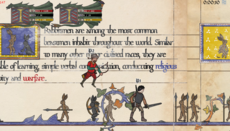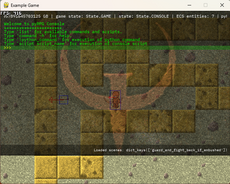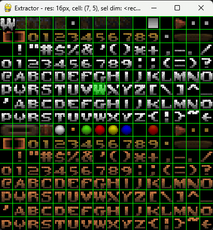#Written by: Josh Taylor (deficite) joshtaylor dot mail at gmail dot com
# and Gordon Allott
import pygame
from pygame.locals import *
import ogre.renderer.OGRE as ogre
from ctypes import *
class PyGameOGREApp:
"Provides a base for an application using PyGame and PyOgre"
def __init__(self, width=640, height=480, fullscreen=False):
self._initPyGame()
self._initPyOgre()
self._createWindow(width, height, fullscreen)
self._createViewport()
self._loadResources("resources.cfg")
self._createEntities()
def _initPyGame(self):
"Starts up PyGame"
pygame.init()
def _initPyOgre(self):
"Instantiates the PyOgre root and sceneManager objects and initialises"
self.root = ogre.Root("plugins.cfg")
self.root.showConfigDialog()
self.root.initialise(False)
self.sceneManager = self.root.createSceneManager(ogre.ST_GENERIC, "Default SceneManager")
#self.root.getSceneManager(ogre.ST_GENERIC)
def _createWindow(self, width, height, fullscreen):
"Creates a PyGame window and sets PyOgre to render onto it"
self.screen = pygame.display.set_mode((width,height))
renderParameters = ogre.NameValuePairList()
window = pygame.display.get_wm_info()['window']
display = pygame.display.get_wm_info()['display']
#prototype for PyCObject_AsVoidPtr
pythonapi.PyCObject_AsVoidPtr.restype = c_void_p
pythonapi.PyCObject_AsVoidPtr.argtypes = [py_object]
#we use the python api to get the display structure that ogre wants
display_address = pythonapi.PyCObject_AsVoidPtr(display)
renderParameters['parentWindowHandle'] = str(display_address) + ':0:' + str(window)
self.renderWindow = self.root.createRenderWindow('PyOgre through PyGame', width, height, \
fullscreen, renderParameters)
self.renderWindow.active = True
def _createViewport(self):
"Creates the user's viewport and camera"
self.camera = self.sceneManager.createCamera("camera")
self.camera.position = (0, 0, 500)
self.camera.lookAt((0, 0, -300))
self.camera.nearClipDistance = 5
self.viewport = self.renderWindow.addViewport(self.camera)
self.viewport.backgroundColour = (0, 0, 0)
def _loadResources(self, rcfile):
"Loads the resource paths from specified resource config file"
cf = ogre.ConfigFile()
cf.load("resources.cfg")
seci = cf.getSectionIterator()
while seci.hasMoreElements():
secName = seci.peekNextKey()
settings = seci.getNext()
for item in settings:
typeName = item.key
archName = item.value
ogre.ResourceGroupManager.getSingleton().addResourceLocation(archName, typeName, secName)
def _createEntities(self):
"For simple demo purposes this can be used to create entities and attach them to sceneNode's"
self.entities = [self.sceneManager.createEntity("robot", "robot.mesh")]
self.sceneNodes = [self.sceneManager.rootSceneNode.createChildSceneNode("robotNode")]
for i in range(len(self.sceneNodes)):
self.sceneNodes[i].attachObject(self.entities[i])
def _createScene(self):
"Prepare the scene. All logic should go here"
pass
def _presentScene(self):
"Render the scene and anything else needed done at the time of presentation"
self.root.renderOneFrame()
def run(self):
"Brings the application to life"
while self._processEvents():
self._createScene()
self._presentScene()
pygame.quit()
def _processEvents(self):
"Process events and take appropriate action"
for event in pygame.event.get():
if event.type is QUIT:
return False
elif event.type is KEYDOWN and event.key is K_ESCAPE:
return False
return True
# Instantiate and run!
app = PyGameOGREApp()
app.run()









